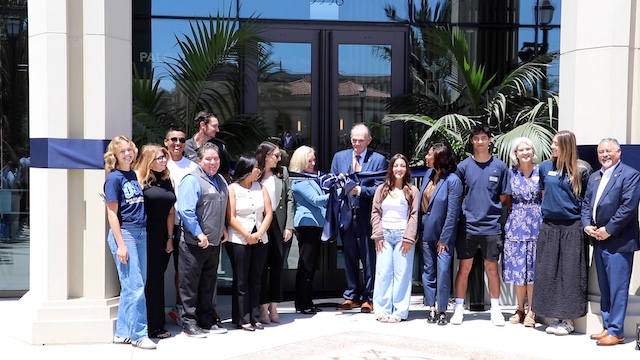USD Law's Children's Advocacy Institute and the California Probation Resource Institute Release Juvenile Justice Report
The California Probation Resource Institute (CaPRI), in collaboration with the University of San Diego, announced the release of its commissioned juvenile justice report by respected experts Jessica Heldman, Professor in Residence in Child Rights at the University of San Diego School of Law, and Melanie Delgado, Senior Staff Attorney at the Children’s Advocacy Institute at the University of San Diego. The report, entitled “The Evolution of Juvenile Justice and Probation Practices in California,” outlines how juvenile justice in California has changed over the past 25 years. It tracks how state law and funding allocations, as well as other policy and practice drivers, have influenced these changes and provides key considerations for the continued evolution of juvenile justice in California.
The California juvenile justice system is comprised of a variety of entities including juvenile courts, county probation departments, and, until June 30, 2023, a state agency providing secure confinement for the most serious offenders. County probation departments have long been responsible for the majority of the juvenile justice population, as almost every juvenile who comes into contact with law enforcement through arrest will interact with their local county probation department to some degree – with 90% of youth being safely served in the community. The report notes, “Local responsibility for juveniles has increased over the past twenty-five years, with additional expansion resulting from the upcoming closure of the state’s Division of Juvenile Justice [DJJ]… As these state priorities and local probation practices have evolved, arrest and detention rates have continued to decrease… the policy and practice developments of the past 25 years correspond with a significant decrease in juvenile offending and incarceration.”
The report specifically examines how juvenile probation policies and practices across the state shifted during the past 25 years and the impact this has had on youth, families, and communities. The researchers found evidence over this time that probation departments have increased their commitment to:
- Promoting prevention and alternative responses to formal prosecution and justice system involvement. Survey respondents indicate a shift in the culture of juvenile probation departments over the past several years toward reducing the number of youths formally processed. State funding through competitive grants supported the development of prevention and early intervention efforts in a number of counties, promoting increased collaborative multi- disciplinary service planning and community- and family-based interventions.
- Using validated risk and need assessments to guide decision-making and case planning. In recent years, county adoption of such tools has been near-universal. Survey results suggest these tools are utilized by probation officers in developing individualized case plans and identifying individually tailored interventions and services.
- Developing and promoting alternatives to detention. The number of detained youths has decreased significantly over the past two decades. While certainly attributable to a reduction in arrests, over the same period probation departments have used state funding to develop a variety of alternatives to detention.
- Redesigning or repurposing facilities. With the decrease in the number of youths detained and a recognized willingness to make change, some counties in recent years have either transformed corrections-oriented facilities into more rehabilitative environments or are considering repurposing or closing their nearly empty facilities.
- Shifting toward a supervision approach that balances oversight and the promotion of behavior change using evidence-based practice. Survey respondents overwhelmingly indicate that facilitating positive behavioral change among youth is a key goal of the juvenile probation officer. In support of this goal, the vast majority of those surveyed note that their department focuses on matching youth needs with appropriate services and utilizes a system of graduated responses to probationer transgressions. In addition, almost all counties report implementing some evidence-based practices within their departments.
“The research is consistent with our own experiences that demonstrate a shift in probation toward promoting prevention and alternatives to incarceration for young people built upon evidence-based, rehabilitative practices,” said San Mateo County Probation Chief John Keene, President of the Chief Probation Officers of California (CPOC). “County probation departments across California have stepped up to the additional demands of serving a much larger population of justice-involved youth after several reforms to the juvenile justice system in 2007, 2010, 2017 and now the closure of DJJ. In every community, probation departments are balancing opportunity with accountability and motivating positive behavior change that helps young people transform their lives and leave the justice system permanently. Our reliance on evidence-based practices, our commitment to promoting alternatives to detention and our use of needs-based, common-sense approaches for the youth in our care is leading to better outcomes and long-term, sustainable community safety.”
"Our report details evidence of positive developments in juvenile justice in California. With state investments as well as evolving research in the areas of adolescent development and effective probation practice, juvenile probation departments have increased emphasis on diversion, alternatives to detention, community supervision, and developmentally-appropriate services and supervision,” said Jessica Heldman, co-author of the report and professor in residence at the University of San Diego School of Law. “Notably, as more youth within the juvenile justice system have been served closer to home and detained and formally processed less frequently, juvenile crime, as measured by juvenile arrests, has not increased. This suggests that the combination of policy, funding, and practice change supporting a more rehabilitative and local approach to juvenile justice has not had an adverse effect on public safety; rather, there is reason to believe this approach has enhanced public safety.”
“The research results demonstrate that probation departments in California are evolving to meet the diverse needs of the youth we serve, and when provided with the appropriate support and resources can effectively implement evidence-based interventions that enhance public safety for the long term,” said Karen Pank, CPOC Executive Director. “As this report documents, probation’s role as a connector in the justice system can play a pivotal role in positively impacting youth in our communities and this is especially important with the shift of responsibilities from the state to local probation departments over the years.”
The CaPRI Institute was started in the summer of 2019 to fill the current lack of cumulative data and analysis about California probation’s approach as most reports focus on national data which does not always take into account the unique factors of California’s system. Over the past decade, California probation has focused on providing rehabilitative and evidence-based approaches leading the nation in many reforms.
This report was made possible by the partnership with esteemed academic experts from top universities and is available for viewing here. A project of CPOC, the Institute is part of a long-term strategic plan to further the evolution of probation practices. It will continue to provide evaluations of juvenile and adult probation with future studies and work to build further strategic partnerships expanding the availability of related resource tools.
For more information about the California Probation Resource Institute, please go to www.CaPRInstitute.org.
To learn more about the Children’s Advocacy Institute at the University of San Diego, visit https://www.sandiego.edu/cai/.
About the University of San Diego
Strengthened by the Catholic intellectual tradition, we confront humanity’s challenges by fostering peace, working for justice and leading with love. With more than 8,000 students from 75 countries and 44 states, USD is among the Top 20 Best Private Schools for Making an Impact according to The Princeton Review. USD’s eight academic divisions include the College of Arts and Sciences, the Knauss School of Business, the Shiley-Marcos School of Engineering, the School of Law, the School of Leadership and Education Sciences, the Hahn School of Nursing and Health Science, the Joan B. Kroc School of Peace Studies, and the Division of Professional and Continuing Education. In 2021, USD was named a “Laudato Si’ University” by the Vatican with a seven-year commitment to address humanity’s urgent challenges by working together to take care of our common home.
Contact:
Elena Gomez
elenagomez@sandiego.edu
(619) 260-2739



